By Steven Smith
This session is the second in a series used for trying out for a collegiate team. The skills required give a good picture of technical abilities of players and can be used as a training session as well. The demands of the transition will reveal the work ethic of individual players.
Activity 1: Brazilian Triangle Series
Warm-up
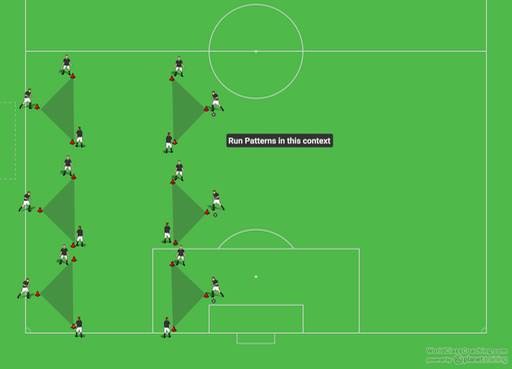
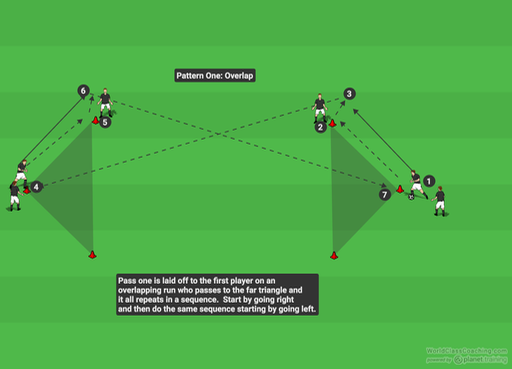
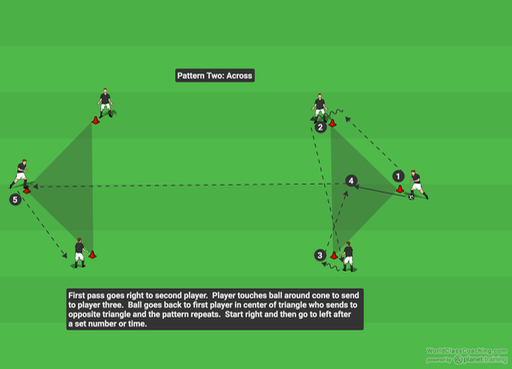
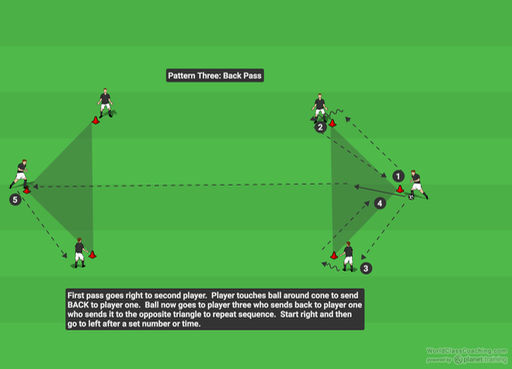
Setup:
Three to four sets of the triangles are set up as shown in the first diagram. Three players are in each triangle and set up on the cone in each location. Distance between cones should be about five yards within the triangle and 15 yards between triangle sets.
Execution:
Players execute a series of predetermined passing sequences as shown in each diagram. Players should eventually become so adept at this warm up that it can be led by the players with the switching of the patterns being done by the leaders of your group. Spend approximately three minutes on each passing sequence before switching sides.
Variations:
1. Coach can set up competitions between the groups to see how many passes in a pattern can be accomplished in a set amount of time.
2. Coach can change up the size of the triangles in increasingly bigger distances and switch groups to each of the increasingly bigger spaces. The precision of passing touches can be translated to the larger spaces that may occur in the game.
Activity 2: Over the River
Main phase
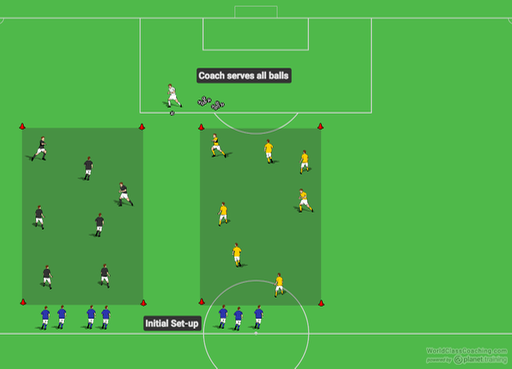
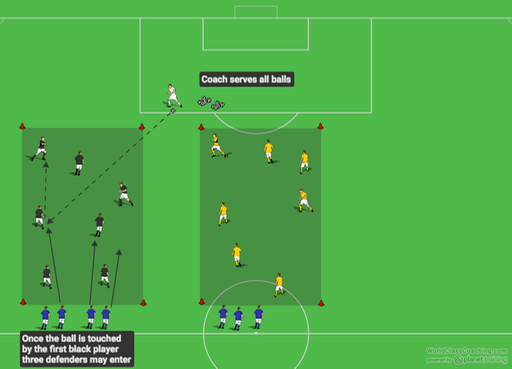
Setup:
This activity is designed to increase possession skills while focusing on transition and fitness. It is perhaps one of the most challenging fitness possession games for a senior level team.
The concept is for two teams to keep the ball for 6-8 consecutive passes and then switch the ball to the next grid over (across the river) in the air to complete a point. The level of difficulty is determined by the space of the possession grid, the intensity and numbers of the opposing team and the distance of the gap between the two possession grids (the river).
Execution:
Two possession grids are set up approximately 25 yards by 35 yards in size with a 20-yard gap between the two fields. Three teams of seven are divided evenly with a black group trying to maintain possession in one grid and complete 6 to 8 passes and then send the ball in the air to the yellow team for possession in the next grid over and past the gap (river) space.
The defenders form the third group and stay outside of the grids until a ball is served by the coach into one of the grids. Once the ball is received by the black team three or four of the defenders must enter the grid to try to break up the possession. If the defenders are able to knock the ball out of the grid, the coach serves to the yellow team and the defenders in that group enter the yellow possession grid to try to knock the ball out of that grid as well.
The possession group is successful by completing the 6 to 8 passes (coach's preference on difficulty). Once the predetermined number of passes is achieved the defenders stop but the possession group has a free pass to send to the opposite grid. If the ball does not reach the opposite grid in the air then no point is scored! Once the ball has reached the new grid the cycle of possession and crossing the river continues.
The coach can determine the length of the game by time or by points achieved or number of balls served. Once the end of the game is achieved the defending color group changes with each successive game. A full cycle for the game is three complete games. Always give a reward for the winning team at the end of a three-game cycle.
Variations:
• The group sizes can be uneven and therefore the coach can predetermine how many defenders can enter the grid. The smaller the possession group, the fewer defenders that should be sent into the grid.
• With groups of seven defenders one person on the defensive team may have to cross the river to help defend if groups of four are required to defend in each grid. The coach can make that person make the transition every time or each person on the defensive group can take turns crossing the river to defend.
Activity 3: 3 v 3 Transition with Wingers
Main phase
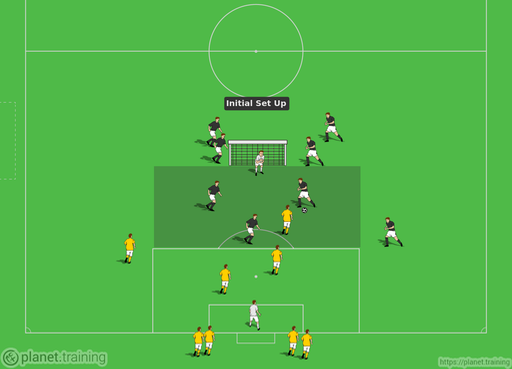
Setup:
Three vs. Three fields are set with full size goals on each end with grid size of 20 X 25 yards. Wingers are outside of the grid on each side waiting to be invited into the game by a pass from one of the central 3 vs. 3 teams.
Execution:
Play is initiated by the keeper serving to their team. Three vs. three is played in the space provided by the grid. If the 3 vs. 3 attacking team wants to invite wing play then a ball is played to one of the neutral wing players (7 or 11) and that player can now add to the field of play. When possession is turned over the winger drops back out of the grid until they are served again through one of the two teams serving to them again. Each loss of possession results in a return to 3 vs. 3. If the ball goes over the end line, then a new group of attackers come at the team that sent it over the end line (like the 2 vs. 2 traditional transition game).
Variations:
• Wingers can only one touch the ball into play and not enter into the field of play.
• Wingers can only cross the ball from outside the field of play.
• Wingers can enter the field of play and one of the others must exit to the winger position.
• Wingers must get to the end line before a cross can be made.
• Players in center may only score with their head.
Activity 4: 4 v 4 Plus 4 Transition Game
Main phase
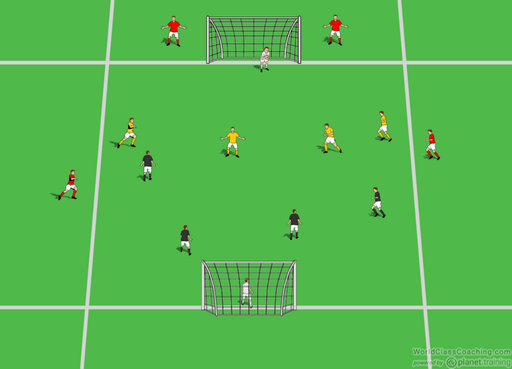
Setup:
The teams are set up as shown with four black attackers vs. four yellow defenders. The red team is lined up on the outside of the field.
Execution:
Teams play four vs. four in the space. The black team attacks the one full sided goal and the yellow team attacks the other full sided goal. The red team is played in by either team but cannot participate until played into by one of the teams in possession. Once possession is lost by either team the red team drops back off until played in again by one of the teams. AS SOON AS ONE TEAM SCORES, THE RED TEAM TRANSITIONS ONTO THE FIELD AND THE LOSING TEAM MOVES TO THE OUTSIDE. The scoring team gets the advantage of make it/take it and tries to score again during the transition of the red team arriving on the field.
Variations:
• Coach can restart every ball.
• Goal keeper can restart every ball.
• Outside team rotates in after every goal or every two goals.
• Always play make it take it.
By Steven Smith Head Coach at Hope College, Holland, MI


